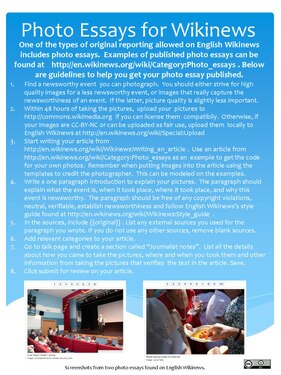|
|
| (19 intermediate revisions by 2 users not shown) |
| Line 1: |
Line 1: |
| As of February 2014, there is one standardised WMUK training handout, namely the:
| | {{Header blue|Handouts|margin-bottom: 0;}} |
|
| |
|
| ;Cheatsheet
| | There are different ways of understanding people's learning styles. One model groups people who learn by visual cues (diagrams and charts), listening (talks, conversations, even one-to-one emails), reading/writing (essays, manuals), and demonstrations (using concrete examples). It is important to address these different styles, and the handouts below are useful for people who learn by reading and through demonstration as they provide detail on different aspects of editing. |
| This is a short wikitext introduction on thin card, dating from 2012.
| |
|
| |
|
| Wikipedia editing is in itself on an evolutionary path, with numerous incremental changes made to the interface, and user experience that varies over time, and according to an editor's status. For example newcomers do not have the same range of features, may be subject to tests such as capchas, and will have their preferences set up by default to a standard which itself is changed.
| | <gallery mode=packed heights=250px> |
| | | File:New Editing WP booklet v4.pdf|A guide to editing Wikipedia |
| Very prominently there is the new
| | File:New Illustrating WP booklet (UK).pdf|A guide to adding files to Wikimedia Commons |
| | | File:Photo Essays for Wikinews.pdf|Photo Essays for Wikinews |
| ;Visual Editor
| | </gallery> |
| which is a WYSIWYG editor for Wikitext. It is still under development, and is available in preferences. No one currently regards this as a finished product that a typical editor would use as their only Wikipedia editing interface.
| |
| | |
| A point that needs discussion is whether the cheatsheet should be modified in the light of the Visual Editor, or whether there should be a parallel development of another handout.
| |
| | |
| A further area in which documentation could be very useful is
| |
| | |
| ;Article creation
| |
| | |
| Here the gulf between the newcomer and the established editor is very large. Technically speaking, creating articles is really easy (if you edit the browser line, say). As a training issue it is fraught with half-a-dozen key points:
| |
| | |
| * notability and choice of topic;
| |
| * choice of title;
| |
| * drafting (sandbox and Draft: namespace);
| |
| * redlinks, copying over of wikitext (for the non-autoconfirmed);
| |
| * minimum requirements to survive speedy deletion nomination;
| |
| * avoiding orphans and adding categories as basic good practice.
| |
| | |
| This is all before encyclopedic writing, content policy and manual of style considerations. The whole business needs to be preceded by some research and marshalling of references.
| |
| | |
| There would seem to be a need for a guide for prospective trainers. Some things, such as choosing a topic and gathering references, are time-intensive, and are not always really feasible within a workshop. The solution is to ask for attendees to come prepared, which is a counsel of perfection.
| |
| | |
| Another area is worth considering:
| |
| | |
| ;Top tips
| |
| Things like autofills from DOIs and the Google Books reference generator http://reftag.appspot.com/ may actually make a very positive impression on workshop participants.
| |
|
| |
|
| [[Category:Training documentation]] | | [[Category:Training documentation]] |
Handouts
There are different ways of understanding people's learning styles. One model groups people who learn by visual cues (diagrams and charts), listening (talks, conversations, even one-to-one emails), reading/writing (essays, manuals), and demonstrations (using concrete examples). It is important to address these different styles, and the handouts below are useful for people who learn by reading and through demonstration as they provide detail on different aspects of editing.
A guide to editing Wikipedia
A guide to adding files to Wikimedia Commons
Photo Essays for Wikinews


